 |
|
| Home | Marine Aquariums |
Freshwater Aquariums |
Planted Aquariums |
Brackish Systems |
Ponds,
lakes & fountains |
Turtles & Amphibians |
Aquatic Business |
Aquatic Science |
Ask the WWM Crew a Question |
| Please visit our Sponsors | ||||
|
Related FAQs: Snakeheads The Good, the Bad, and the Ugly: Snakeheads By Neale Monks Snakeheads are a family of Asian and African freshwater fish that are closely related to gouramis and Bettas, but physically look more like short, stocky eels. Like gouramis they’re air-breathers, many species being adapted to life in swamps and sluggish streams where the amount of oxygen in the water can become critically low at certain times. But whereas the typical Gourami or Betta is a small fish that feeds on insect larvae or algae, some snakeheads are huge predators capable of taking a wide range of prey including frogs, crayfish and even waterfowl. There are some smaller species within the snakehead family Channidae though, and these can make very good aquarium fish, only getting to around 20 cm/8 inches in length. While they’re still predators, they’re otherwise undemanding and easily maintained, perfectly suited to moderately experienced aquarists interested in unusual oddballs but without the space needed for the more traditional ‘tankbusters’. But hang on a second! Aren’t snakeheads illegal? Depends on where you live! Importing live Snakeheads is illegal in the United States, regardless of species, under the Lacey Act of 2002, where the entire family is listed as injurious, with the potential to cause severe harm to native ecosystems. The Fish & Wildlife Service is aware that only a minority of snakehead species are truly cold tolerant, but argue that even the subtropical and tropical species do pose a certain level of risk. The tropical species could become established in places like Hawaii, southern Florida and southern California, while the subtropical species, being that bit more adaptable, could be established more broadly, including perhaps most of the southern States. The Lacey Act prohibits any type of trade or transport of snakeheads, whether as eggs or fish, and regardless of whether fish are being moved into the USA or across State boundaries. Needless to say this has put a complete stop to the import of Snakeheads from the Asian countries that export them, but the USGS state that, where local laws allow, it remains legal for American aquarists to keep snakeheads as pets. Quite a few of the States have banned ownership of Snakeheads though, including Alabama, California, Florida, Texas, Virginia, and Washington. Others require the owner to obtain a permit. The USGS therefore recommends that aquarists interested in these fish obtain information about the regulations concerning their possession from their state fish and game agency. Some other countries have enforced similar restrictions on the import and ownership of snakeheads, though blanket bans are rare. In Canada for example it’s only the cold-tolerant Northern Snakehead, Channa argus, which has been subject to a local ban in British Columbia, the other species remaining legal, if uncommonly seen in the trade. The European Union has also looked at the family, and though a complete ban appears to have been rejected as of December 2017, the member states may restrict or ban particular species. So in the United Kingdom it is again Channa argus that has been identified as the biggest risk and banned from the aquarium trade, but other species remain on sale, particularly the smaller tropical and subtropical species. The bottom line is therefore has to be check before you buy! While the American hobbyist’s access to snakeheads is certainly minimal, elsewhere in the world a more liberal approach frequently exists, and good retailers should be able to get hold of them without too much trouble, even if they’re not routinely held in stock. Why keep a snakehead if it’s just some sort of psycho killing machine? Because they’re not! When we’re talking about snakeheads were talking about a family of some forty or so species that inhabit a wide variety of habitats and occupying a broad range of ecological niches. Many of the smaller species are colourful and active, and as rule snakeheads are hardy fish that place few demands on their owners. In short, if you like oddball fish, you’re going to find snakeheads a real treat! Okay, I’m sold! How do I keep them? The main thing with snakeheads is to choose the right size tank for the species in question. Obviously those giant species able to eat ducks and frogs aren’t going to be suitable for even the biggest home aquaria, but many snakeheads fall into the 15-40 cm/6-16 inch range, and these are perfectly viable options. Take for example Channa bleheri, the popular Rainbow Snakehead. This is a fish that reaches a maximum length of 15 cm/6 inches or so, and could be maintained adequately well in an aquarium measuring around 100 litres/30 US gallons. Apart from mated pairs, individuals of this species are aggressive towards each other, but that doesn’t mean they can’t be kept with robust tankmates that won’t compete for food, for example Synodontis or L-number catfish of similar size. At the other end of the size range are things like Parachanna obscura, the African Snakehead. This is a much bigger fish, up to 40 cm/16 inches in length, and thus a fish that needs a lot more space to do well. This time we’re talking about a tank around 240 litres/60 gallons in size; a big tank, yes, but nothing too extravagant. Again, these fish don’t get on well with one another, and given their size, mixing them with other fish is probably risky. But while the African Snakehead is usually kept alone, and will need filtration adequate to its size, it is otherwise undemanding, placing no special demands on its owner in terms of either diet or water chemistry. Indeed, the main risk that will need managing is the fact snakeheads tend to jump out of their aquarium given even half a chance! A secure hood is essential, and some effort should be made to ensure there are no gaps in the hood that might allow an errant snakehead to sneak its way out of the tank during the night. Other considerations including water temperature, water chemistry, and tank décor. The snakeheads kept by aquarists come from either subtropical or tropical environments, and the heater-stat should be set accordingly. Subtropical species are happiest around 18-22˚C/64-72˚F, and will generally do perfectly well in unheated tanks maintained at normal room temperature. Seasonal changes, and nighttime cooling, will help to keep them in good health. The tropical species should be kept between 25-30˚C/77-86˚F, which usually means a heater will be essential, even in a centrally heated home. Water chemistry is rarely a critical issue, but most species do come from places where the water is naturally soft and slightly acidic, so that is probably the ideal, particularly if you intend to breed them. As a rule snakeheads like tanks with plenty of overhead shade (floating plants are ideal), smooth water-worn rocks and bogwood roots, and a smooth gravel substrate that will be easy to clean. Avoid sand because these active fish will likely disturb it. When choosing plants for the bottom of the tank, you might want to opt for epiphytes such as Anubias and Java Fern that can be moved about easily when you need to clean the tank. Do these things need feeder fish? Nope: the idea that snakeheads only take feeder fish is completely erroneous and potentially risky if those feeder fish are the cheaply produced but basically unhealthy ‘parasite bombs’ of the sort doled out in some quarters. While they certainly enjoy live foods, these don’t have to be fish; earthworms and river shrimps will do just fine, and the bigger species will also take things like crickets and mealworms. If that isn’t to your taste, then by all means offer frozen alternatives including strips of white fish fillet, prawns, cockles and squid. Smaller snakeheads will also consume bloodworms, mosquito larvae and so on. As with any carnivore, the key to success is variety. Certain foods, notably prawns and mussels, contain thiaminase, an enzyme that breaks down vitamin B1, leading to serious health problems in the long term. So while nutritious and useful as treats, foods lacking thiaminase, such as cockles, tilapia and pollack, make much better staples. Alternatively, the use of vitamin supplements of the sort more widely used by marine aquarists can be helpful. Snakeheads will also take good quality pellet foods once they get use to them; the author had no trouble getting his Channa asiatica to take Hikari Cichlid Gold for example. So what’s out there? Thanks to the demand for these fish in Europe and Japan, a steadily increasing range of snakeheads has become available from collectors in Southeast Asia, particularly Burma. Some may well be new species, while others simply regional variants. There is also a certain amount of captive breeding going on, and it may well be that we’ll eventually see ‘fancy’ varieties of snakeheads appearing in the trade just as we have with various cichlids, Arowanas, and so on. Orange-Spotted Snakehead, Channa aurantimaculata Channa aurantimaculata gets to around 35 cm/14 inches in length and comes from the Brahmaputra River in India. Adult specimens have small orange spots all along their flanks and on their dorsal fins. They also have bright metallic blue markings on their face and fins. These colourful fish are not difficult to keep, but like many other subtropical fish it likes cooler winters and warmer summers, which the wise aquarist will provide by turning the heater-stat up or down as required. A cooler, wintertime low around 18˚C/64˚F for two or three months will do the trick nicely, while the rest of the year it should be kept at around 25˚C/77˚F. This is one of the more territorial snakeheads and is best kept alone. 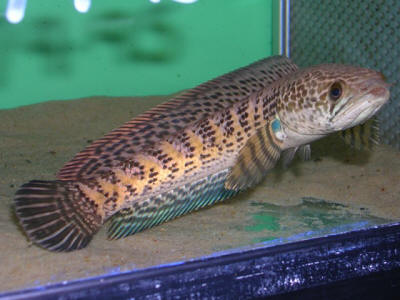 Bangka Snakehead, Channa bankanensis This snakehead has more cryptic colouration than many of the others, presumably helping it to hide more easily in its natural habitat, blackwater streams in the tropical rainforests of Indonesia and Malaysia. Juvenile Channa bankanensis are pale pinkish-brown with a line of dark patches along their flanks, but as they mature their colours darken and the fish acquires a mottled brown colouration that looks especially good in a deep, dark tank with plenty of vegetation and bogwood. Maximum length is around 30 cm/12 inches, though often a bit smaller. Given its natural habitat, water chemistry should tend towards the softer end of the range, though true blackwater conditions do not seem to be necessary. 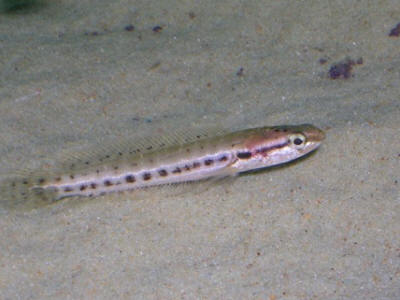 Rainbow Snakehead, Channa bleheri Since this snakehead species gets to around 15 cm/6 inches in length but sports the most brilliant blue, orange and brown markings, this Indian species has become a firm favourite with aquarists in Europe. Note that stressed specimens and youngsters may look rather nondescript, as is the case with the specimen photographed here, but once settled down and sexually mature Channa bleheri are lovely, probably the most colourful of all the snakeheads. Like Channa aurantimaculata is a subtropical species that does well if kept cooler in winter than summer, but otherwise Channa bleheri is a very undemanding species with much to recommend it. It consumes a wide range of fresh and frozen foods, and places no particular demands in terms of water chemistry. 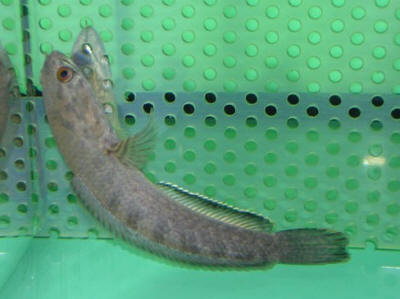 Great or Bullseye Snakehead, Channa marulius This snakehead is native to a large part of Asia from Pakistan to China, and as you’d expect from that, it’s an undemanding and adaptable fish. On the other hand, given FishBase reports a maximum length of over 180 cm/70 inches, Channa marulius isn’t a viable option for the home aquarist. 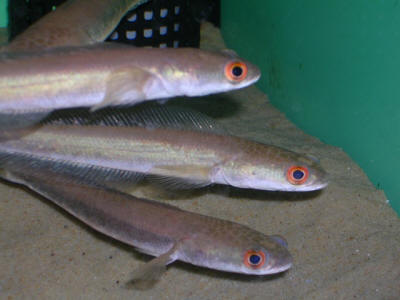 Giant Snakehead, Channa micropeltes The author well remembers a time during the 1980s when juveniles of this species were routinely sold in British aquarium shops. Beautifully marked with a thick red band along each flank, edged with black, these lively fish certainly caught the eye! But adult specimens reach at least 90-100 cm/35-39 inches within a couple of years, by which time they have lost their red colouration and instead acquired a sort of mottled steel-grey livery instead. Widely farmed in Asia, Channa micropeltes is not at all suitable for the home aquarium. 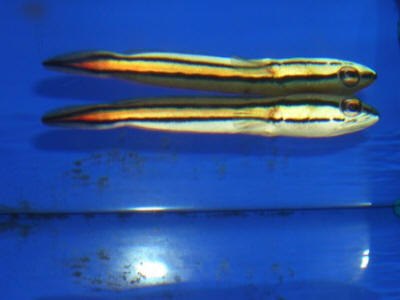 African Snakehead, Parachanna obscura Parachanna obscura is one of only five snakeheads native to Africa, and while never a common import, does turn up from time to time. Given its maximum length is around 40 cm/16 inches, this is a big fish, but it has been kept in mixed-species tropical set-ups alongside such fish as giraffe catfish and the larger bichirs. Parachanna obscura is not fussy about water chemistry or diet, but its mottled colouration reveals its preference for deep, dark tanks with plenty of shade or floating vegetation. 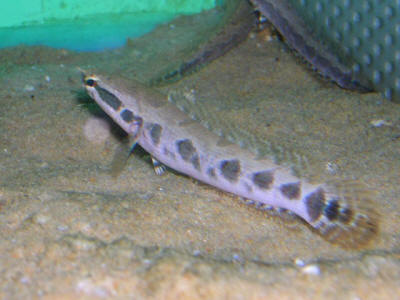 Ceylon Snakehead, Channa orientalis This is another of the ‘dwarf’ snakeheads, Channa orientalis reaching a maximum length of around 10-15 cm/4-6 inches. Despite its name, this species is not only found in Sri Lanka (formerly, Ceylon) but across a wide swathe of Asia from Iran to China. Unsurprisingly this is adaptable tropical species occurs in a number of distinct colour forms. The standard Channa orientalis is metallic blue with orange, white, blue and black markings on its fins. Some European aquarists have managed to keep groups of juvenile Channa orientalis in large tanks, allowing pairs to form as they mature. Once in their own tank these mated pairs were seen to be mouthbrooders, though not particularly easy to breed. Burmese Blue-spotted or Ornate Snakehead, Channa ornatipinnis Channa ornatipinnis was one of two snakehead species described by Ralf Britz in 2007, the other species being Channa pulchra. Both come from Burma. Channa ornatipinnis is a very attractive species, and while not exactly small, with a maximum length of around 25 cm/10 inches, this is still one of the most manageable species, at least in terms of size. Most reports seem to agree that this species is highly territorial and best kept alone. Furthermore, as a subtropical species, it’s hard to recommend any potential tankmates; the otherwise obvious choices, such as L-numbers, simply won’t handle the cool conditions this species needs. In short, while not a difficult fish to keep, Channa ornatipinnis is not quite so easy as some of the others. 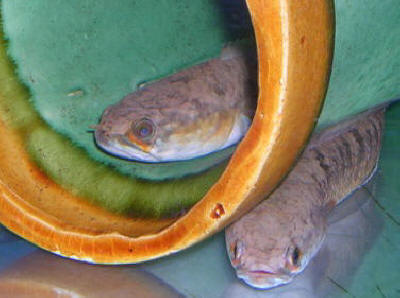 Panaw Snakehead, Channa panaw Channa panaw is another ‘dwarf’ species that reaches around 17 cm/7 inches in length. On the one hand this tropical species is not as colourful as some, basically pale golden-brown with dark blotches on its flanks and small black spots on its fins. But it is lively, hardy, and peaceful, making it one of the easier options for use in a mixed species set-up. Indeed, some aquarists have managed to keep groups of these fish together without problems, though as with other dwarf snakeheads, the author would still recommend keeping them either on their own or in mated pairs. 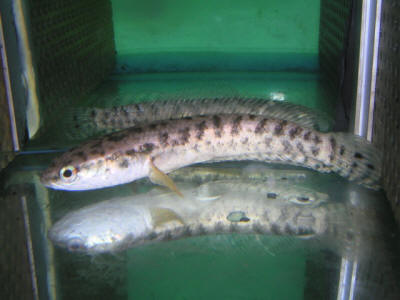 Ocellated Snakehead, Channa pleurophthalma Sometimes written as Channa pleurophthalmus, this is a medium-sized tropical species from Southeast Asia. Juveniles are somewhat plain, but the adults have bodies marked with steely-blue spots and a series of orange-rimmed black eyespots running along their flanks and onto the base of their tail. While their adult size of at least 30 cm/12 inches puts them into the more demanding category of snakehead, Channa pleurophthalma are not otherwise problematical when kept singly or alongside robust, dissimilar fish of similar size. Wild fish supposedly occur in loose groups, but under aquarium conditions this species can be snappy towards its own kind, and doesn’t form the sort of stable mated pairs characteristic of some of the other species. 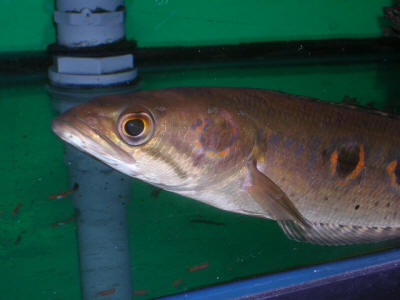 Pretty Snakehead, Channa pulchra Channa pulchra was one of the Burmese species described by Ralf Britz in 2008, and quickly became a favourite in the European hobby. Like some of the snakeheads mentioned in this article, this subtropical species likes to be kept cool during the winter, around 22˚C/72˚F being about right. For the rest of the year, the usual 25˚C/77˚F will be fine. Although this species is sometimes described as one of the ‘dwarf’ snakeheads, Channa pulchra can reach a respectable size, 25 cm/10 inches being typical. It is very pretty though, with electric blue dorsal, anal and tail fins, and bold black and white bands on its pectoral fins. It has a distinctive black spot on its dorsal fin, and numerous black speckles and orange blotches along its flanks. All in all a stunning species, albeit one that will require a bit more space than the true dwarf snakeheads. 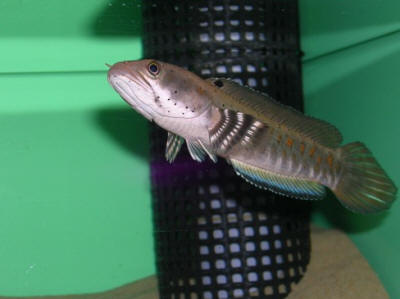 Assam or Golden Snakehead, Channa stewartii Channa stewartii is another subtropical species from India, and like the others requires a cool winter period to do well. This species is quite attractive, with a green-gold body bearing orange blotches, and some metallic blue colouration on the unpaired fins, particularly the dorsal fin. There is a fair amount of variation within the species, including forms that are bluer or more golden than the norm. Maximum length is around 25 cm/10 inches. While easy enough to keep, Channa stewartii is intolerant of its own kind, and sometimes aggressive even towards dissimilar fish, so best kept alone. 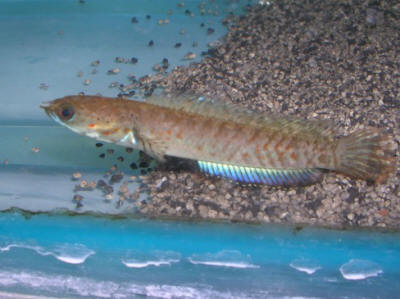 Undescribed species Many other snakehead species are seen in the trade, though their precise identity remains uncertain. Some may be new species, others mere varieties of existing species. A selection are listed below: Channa "Fire-and-Ice" is a dwarf species that reaches up to 15 cm/6 inches in length and comes from Burma. Although this tropical species is undemanding with regard to water chemistry and water temperature, it is quite snappy for its size, and best kept either singly or in mated pairs. Its trade name comes from the vivid red and blue markings on its head and fins. 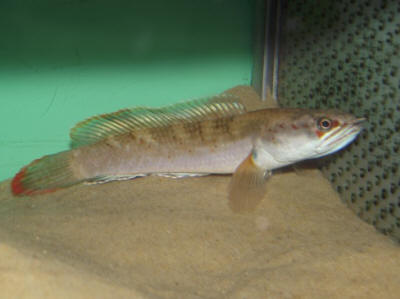 Channa "Kerala 5-stripe" is a small (to 20 cm/8 inches) species from northern India. As with the other subtropical species this snakehead will need a cool winter period to do well. Basically mottled silvery-grey in colour, these snakeheads sport five dark saddle-like bands across its flank that makes it highly distinctive and very attractive. Channa "Kerala 5-stripe" do not appear to be particularly aggressive, and may be kept either singly or as a mated pair. 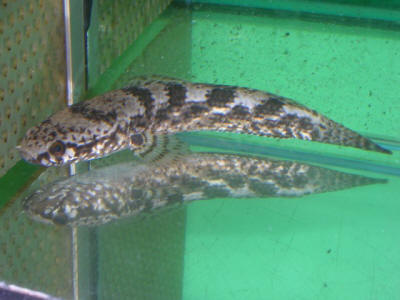 Channa "Laos fireback" is another small (to 20 cm/8 inches) subtropical species. This species gets its name from the orange band running along the edge of its otherwise bluish dorsal fin. Channa "Laos fireback" is quite an aggressive fish, and unless the tank is exceptionally large and sufficient for a decent group of them, it is best kept on its own. 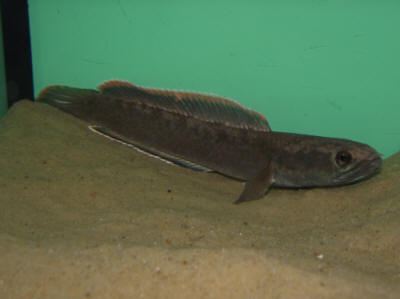 Channa "Moonbeam Galaxy" may simply be a variety of Channa stewartii with bluer colouration than normal. It certainly gets to about the same size, around 25 cm/10 inches, and needs to be kept in the same sort of way. In any case, these fish have a blue-grey body with black speckles, and powder blue unpaired fins edged with black and white bands. Their colours become especially intense in dark tanks with lots of bogwood roots and floating plants. 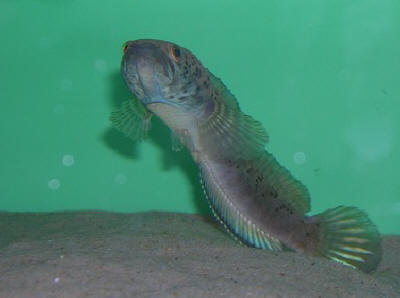 |
|

|
Features: |
|
| Featured Sponsors: |